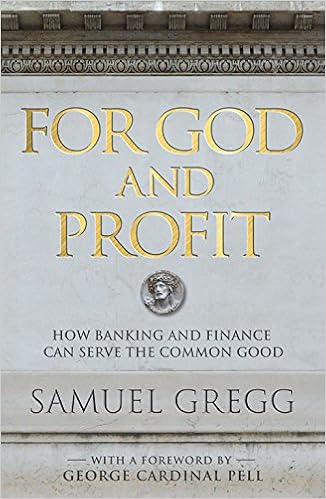Sam Gregg of ACTON on medieval distinctions about usury and legitimate forms of money-lending
 I saw at American Banker an interesting article by Sam Gregg of Acton Institute which is excerpt from his new book For God and Profit: How Banking and Finance Can Serve the Common Good. UK HERE
I saw at American Banker an interesting article by Sam Gregg of Acton Institute which is excerpt from his new book For God and Profit: How Banking and Finance Can Serve the Common Good. UK HERE
How Medieval Monks Changed the Face of Banking
Given that he was a member of the famously ascetic Franciscan order with his own reputation for detachment from worldly things, St. Bernardine of Siena (1380-1444) was remarkably insightful about money. [And about certain immoral acts, too. And he wasn’t shy about preaching about them. Also, note that Franciscans are friars, not monks.]
Understandably, most people are surprised to learn that some of the important intellectual developments that first enabled finance to become an engine of growth were made by men like Bernardine who had, for the most part, freely taken vows of poverty.
Like all medieval clergy, Bernardine fiercely opposed usury. [As did the Fathers of the Church.] In a sermon, Bernardine wrote: “Usury concentrates the money of the community in the hands of a few, just as if all the blood in a man’s body ran to his heart and left his other organs depleted.”
Yet the same Bernardine also invested time in explaining why it was legitimate for creditors to charge interest on loans to compensate themselves for relinquishing the opportunity to invest their money elsewhere. [That was not what the Fathers would have approved.] In such circumstances, he believed the lender had a right to be compensated for what amounted to foregone profits.
He wrote: “What in the firm purpose of its owner is ordained to some probable profit has not only the character of mere money or a mere thing, but also beyond this, a certain seminal character of something profitable, which we commonly call capital.”
This title, known as lucrum cessans (profits given up or what we today might call the opportunity cost of liquid funds) reflected the insight that money was not always sterile and could become productive: money could turn into capital.
Franciscans didn’t limit themselves to writing about such issues. From the 14th century onward, they sought to help the needy gain access to credit in the form of loan companies. The first of these lending institutions — more popularly known as montes pietatis — were established by Franciscans and initially funded by donations from wealthy Christians. The montes pietatis lent money to relatively poor people who were unable to access loans from established moneylenders. Borrowers would provide the montes with small items of value as a form of security for the loan’s repayment.
Controversy arose, however, when the montes began charging interest that ranged between 4% and 12%. One of their strongest boosters, another Franciscan, Bernardine of Feltre (1439-1494), insisted that some interest-charging by such institutions was essential if they were to become self-sustaining. Eventually, this became the norm for all Franciscan-established montes. Not surprisingly, they were also eventually accused of engaging in usury.
The montes and their interest-charging practices were, however, vindicated, first by Pope Paul II in 1467 when he approved the original montes in Perugia, [Barbo, an interesting guy. The nephew of Eugene IV, he rose in the ranks quickly. Before his election he promised to give every cardinal a summer villa to beat the heat. He was elected by acclamation at the first ballot.] and then by Pope Leo X in 1515 [Medici… he excommunicated Martin Luther in 1521. So, Popes who are not always models of perfect holiness can do good things! Which would be prefer, I wonder… Popes who are pious, but who do things to damage the Church, or Popes that are crafty and do things to build up the Church.] when he issued the papal bull “Inter multiplicis” also affirming that montes were not engaged in usury.
Subsequently, hundreds of montes emerged throughout Italy, France, Austria, Germany, Flanders and Spain. One of the earliest, the Monte dei Paschi di Siena, was founded in 1472 and still exists today. It is Italy’s third largest bank and employs thousands of people around the world.
Despite papal approval, usury accusations against the montes didn’t disappear. This produced defenses of their interest-charging by scholastic thinkers such as the 16th century Dominican Martín de Azpilcueta (1491-1586). He argued that the interest was, strictly-speaking, a charge for administering the loan rather than a direct payment for the loan. [Another friar]
Many people today look at the way in which Christian thinkers reacted to these developments throughout the medieval and early modern period with some cynicism. [!] More than one person has suggested it amounted to Christians engaging in torturous semantics to help Christianity adjust to widespread economic changes as the world’s first forms of capitalism began taking root in medieval Europe.
To reduce such intellectual development to a crass adjustment to circumstances would be a mistake. Certainly, context is important. But it’s also true that an environment of immense economic change stimulated many Christian scholars from the 11th century onward to rethink the nature of money. Over time, they developed a series of important insights and clarifications — the most significant being a clear distinction between usury and legitimate forms of money-lending.
These writers did not approach these issues as economists. They addressed these questions in the context of moral theology and law.
In short, the ideas that drive modern banking — like the banking profession itself — have a much deeper pedigree than many people realize. That’s not a bad thing to keep in mind in an age when bankers and banking are viewed with much suspicion.
And… let’s all say it together!
ACTON INSTITUTE!
